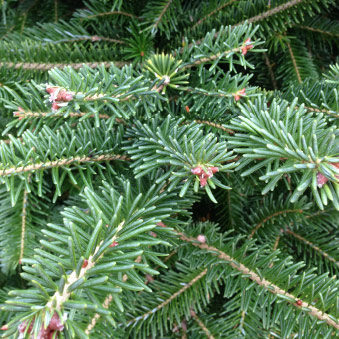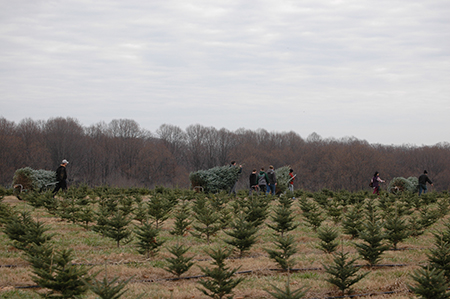
Canaan (pronounced “Ka-naan”, with emphasis on the last syllable) is a relative newcomer to the Christmas tree market. It has many similarities to both Fraser and balsam firs in growth and appearance. Unfortunately, this similarity which has led to a great deal of confusion.
In 1909, a variety of balsam fir was described in the literature as having cone scales extending from the bracts. This morphology was a deviation from typical balsam fir cones where the scales are not extended. This variety was then named “phanerolepis” which actually means conspicuous scales. The scientific name of Abies balsamea var. phanerolepis was assigned. The common names most often used were “bracted balsam fir” and “Blue Ridge fir”. Canaan fir had not, at that time, been described separately.
Bracted balsam fir is found from Labrador to Ontario, and from the coast of Maine to the higher mountains of Virginia and West Virginia. The environments in which most natural stands are found is quite similar to those of balsam fir and Fraser fir. The optimum habitat appears to be a cool climate, abundant moisture and deep, well-drained soils. Soils are moderately to strongly acidic.
In the mid 1930’s, suggestions were made by several authors that some specimens of the variety phanerolepis had a sufficient number of traits of both balsam and Fraser fir that it should not be recognized as a variety but as a separate species. These specimens were generally found in West Virginia and Virginia. One author suggested the name be changed to Abies intermedia to reflect this intermediate nature of the plants’ characteristics. The classification as a separate species has since fallen out of favor, but some commercial nurseries still market the trees as Abies intermedia.
Where does Canaan fir fit into the scheme? Canaan fir is so-named because several of the original trees with the intermediate morphology were identified from a limited area in West Virginia, generally referred to as the Canaan Valley. Taxonomically, Canaan fir is considered the same as bracted balsam fir and has the scientific name of Abies balsamea var. phanerolepis. However, growth traits of the trees from these southern regions are somewhat different than for other bracted balsam fir. Thus, there occurs a dilemma as to how Canaan fir should be classified. There are lots of opinions. The simplest solution is probably to consider Canaan fir as a special ecotype of bracted balsam fir; this ecotype having unique characteristics as a result of the environment to which it has been exposed. It is not currently considered a separate species.
Details of this tree species provided by National Christmas Tree Association

Caring for your tree
Thank you for purchasing a Christmas Tree at Pine Valley Farms. You may have noticed dead needles inside the tree.
Evergreen trees shed their inside needles every fall and sometimes needles lodge among the branches.
This is a normal process and not the sign of a old tree.
To keep your tree fresh as possible, we recommend the following care.
1. Cover your tree for the ride home.
2. Once the tree is home, make a fresh , straight cut across the trunk about an inch from the original cut.
This opens the tree stem so it can take up water. Then plunge the trunk end immediately into fresh water.
If the water level drops below the fresh cut, a seal will form and a new cut will be necessary.
3. Trees are thirsty. They may drink between two pints and a gallon of water per day.
